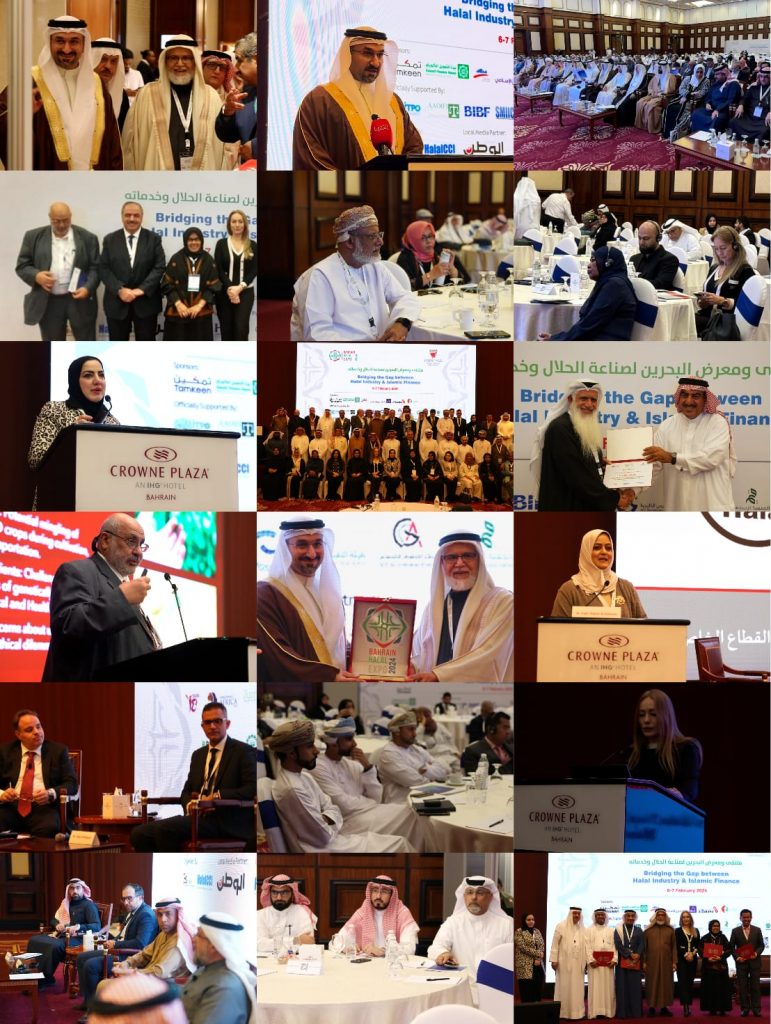 This article was originally written for The Halal Journal Magazine, published in Malaysia by KasehDia, in October 2006, by the late Hajj Abdalhamid David Evans. He was the visionary behind the first World Halal Forum held in the same year in Kuala Lumpur. The vision that Abdalhamid lays out in the article is for the future. We are now in September 2019, 13 years later, how far have we gone in achieving his vision for Halal Food and Islamic Finance to become ‘Natural Allies’? Salama Evans, Managing Editor, HalalFocus.com
This article was originally written for The Halal Journal Magazine, published in Malaysia by KasehDia, in October 2006, by the late Hajj Abdalhamid David Evans. He was the visionary behind the first World Halal Forum held in the same year in Kuala Lumpur. The vision that Abdalhamid lays out in the article is for the future. We are now in September 2019, 13 years later, how far have we gone in achieving his vision for Halal Food and Islamic Finance to become ‘Natural Allies’? Salama Evans, Managing Editor, HalalFocus.com
Kuala Lumpur – 3 October 2006: At my presentation at the recent Middle Eastern Food Marketing Forum in Dubai, I finished with the statement that the emerging global market for halal products and services represented the tip of the iceberg of the impact of Islam on commerce, a convergence which we believe is destined to be one of the defining factors of the coming decades.
At The Halal Journal we are focusing exclusively on what we define as the ‘Global Halal Market’. By this, we are referring to a dynamic market arena for halal products and services, trading according to halal transaction and contracts, using – ultimately – halal currencies.
The two major components of this market are halal food and Islamic finance. These two elements represent an emerging market force that is effectively the direct result of the impact of Islam on commerce. These two – food and finance – are not separate markets. They are rather two faces of one coin, with similar developmental histories and with many parallels.
Both began out of the need of the Muslims to have halal goods and financial services. Initially, both served a primarily Muslim market.
Those who were quick to understand the potential power of this market, got into position. The major food producers – Nestle, Unilever, Walls – and fast-food chains – MacDonald’s, KFC, Burger King – as well as the major meat producers around the world – Australia, New Zealand, India, Brazil, Argentina, USA and UK – all saw the potential of the halal market and took advantage of this multi-billion dollar market.
This has been basically paralleled by the development of Islamic banking. Initially developed by the Muslims to serve the needs of the Muslims, the major banking houses around the world, mostly from the non-Muslim world, have been quick to recognise the potential returns.
If you monitor news items on Islamic banking, everyday you will see new developments, worldwide, as in Malaysia, now with 5 domestic and 3 international fully-fledged Islamic banks, and every other bank with an Islamic window demonstrating the rapid growth in this field. Similarly in the GCC region, Islamic banking is developing at an unprecedented rate with both local and international banks jockeying for position.
In the UK, with the recent opening of the first dedicated Islamic bank, the Islamic Bank of Britain, and the move by Lloyds TSB to offer Islamic banking on the high street can leave no doubt that Islamic banking is transforming from a specialist to a main-stream phenomenon.
We maintain again; these are not two separate phenomena; they are two parts of one phenomenon, the impact of Islam on commerce, and the inevitable emergence of a global halal marketplace.
Dynamics of growth and boundaries.
So where is this heading? Islamic banking is a work in progress, not a finished product. Like the market for halal products, it is a fledgling industry now developing global standards.
Both halal food and Islamic finance are driven by two dynamic – and sometimes opposing – forces that fuel their growth and determine their shape; the desire for growth and innovation – and therefore market share – and the need to remain within the parameters of the Shariah of Islam.
In both the halal food market and the Islamic finance market, we can perceive similar prevailing conditions.
- Vibrant growing market demand, both retail and commercial
- Strong interest from producers and suppliers worldwide
- A dawning recognition of the potential size and strength of a market of 2 billion consumers – likely to be close to 3 billion by 2010
- Dynamic crossover components – not just a market for the Muslims. Among both producers and consumers there is a strong non-Muslim element.
- Global reach. SE, Central and West Asia, GCC region, Europe, US.
Recent geopolitical currents have driven Islam firmly into the public awareness, most of it negative, but frankly, that is to be expected. However, both halal food and Islamic finance are riding on this wave of heightened awareness and curiosity, which is not about to diminish. And there are other factors at work.
For example, ethical awareness is becoming a dominant feature in many market sectors, and markedly so in the food market. Halal food represents the ‘lawful and wholesome’, therefore it encompasses such elements as the current – and growing – concern for the environment, ethical and humane treatment of animals, healthier meat, moderation in consumption, and quality control from the farm to the plate.
Islamic finance similarly must represent justice and equity in the transaction, abandoning riba according to the command of Allah, removal of doubt in transactions, sharing risk and reward in investment, protecting the disadvantaged.
So, what began as a service just for the Muslims, has expanded to serve the needs of others also. Halal meat is not just the preference of the Muslims, as the figures in UK demonstrate, where there are 6 million consumers of Halal meat, and only 2 million Muslims.
Similarly, Islamic banking is also the choice of many non-Muslims, as in the figures from one of the leading Islamic banks in Malaysia, 80% of whose commercial customers are non-Muslim Chinese.
So where is this leading?
Two interrelated components that began separately, serving the same market, are now expanding to serve a wider market, both high growth sectors of their particular markets.
And both now calling for global standards. In this respect, Islamic finance is more advanced, with the creation of the Islamic Financial Services Board and other entities serving as consultative bodies to develop global standards for Islamic banking practices worldwide.
There is a similar call emerging for global standards for halal products, and this is likely to be one of the major developments – and challenges – in the coming years.
As a media company that focuses exclusively on the halal markets, we have from day one considered Islamic finance to be an integral component of the halal market. KasehDia’s involvement in MIHAS 2004, the world’s leading Halal-only trade expo was instrumental in ensuring a strong representation from the Islamic banks, making the event the first fully integrated Halal market event.
We predict that as these two elements continue to grow, the zone of overlap will naturally increase, creating a synergy that will not only benefit both markets, but will actually benefit people all over the world, from all races, colours and creeds.
Why? Because halal is for everyone, not just the Muslims, as is stated in the Qur’an, “Oh Mankind! Consume what is lawful and wholesome from the earth.” For a great many people this includes not just the food, but also the transactions that produce and procure it. As Imam Malik said in al-Muwatta, “What makes a transaction halal, makes it halal. What makes it haram, makes it haram.”
So I return again to my opening statement, with an added component – Halal products and Islamic finance are the two main components that comprise the impact of the Islamic Shariah on the world of commerce. Halal produce, halal transactions, and we hope in the future to see the advent of halal currencies.
One of the perceived weaknesses with the Islamic banking sector is that it is not connected to any real market or industry; it is still, like the riba-based banking system, still primarily concerned with ‘making money’ as opposed to promoting trade and production. As an industry, it is still focussed on the same issues as the riba-based model. The development of the Islamic banking system is a work in progress. It is only a step. The danger is that it will remain a banking-based financial model instead of a trade and production-based model.
Nothing Ventured, Nothing Gained
Venture capital, for example, is mostly conspicuous by its absence in the world of Islamic banking, and yet, by its very nature, it is based on the Islamic model of financing. Venture capital is a process of cooperation between entrepreneurs and venture capitalists, with risk sharing an essential element.
Entrepreneurs provide the bright ideas and hard work, and the venture capitalists furnish the money — either their own or that of their clients — as partners, not lenders. If the business succeeds both parties benefit and in case it fails the entrepreneur is not obligated to repay the investment. This is the essence and spirit of Islamic finance.
Venture capital has played a leading role in the development of innovative industrial development in the USA. The Silicon Valley computer revolution was fuelled by venture capital; HP, Intel, Sun Micro Systems, Apple Computer, Netscape, Intuit, Compaq Computer and Cisco Systems were financed by the venture capital industry in the form of equity capital.
Venture capital rewards innovation, bright ideas, hard work, intelligent risk-taking, honesty; it acts as a catalyst that creates genuine new wealth, new jobs and new industries.
I believe that it is fair to say that one of the contributing factors behind the Muslim world’s general backwardness has been the lack of readily available venture capital. This is the job of the Islamic banks. Interest-free banking cannot be the only goal. That is a bit like taking the alcohol out of wine; it may make it technically drinkable, but it is not the best thing that you can do with grapes.
It is time that the Islamic banking industry looked more closely at the role that it plays in promoting industry and trade. They have demonstrated that they can swim with the big fish; now it is time to make the garden grow (and the farm, the factory, the port and the market!)



